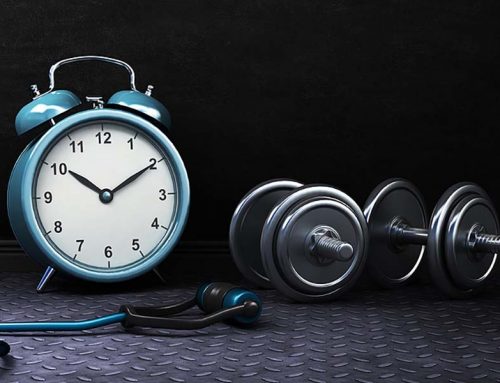Throughout my career in fitness, I’ve witnessed countless people fail to get the results they wanted. They stayed the same size, same shape, and same fitness level no matter what they tried. Or, they made great progress for a few weeks, maybe a few months if they were lucky, and then they lost it all. This cycle can repeat itself for years. The ups and downs lead to overwhelming frustration, which ends with falling off the wagon and swearing you’ll start all over again someday.
 Being bombarded by diet fads and training trends that promise six pack abs” in minutes a day” doesn’t help. Every day we watch the endless parade of shiny new weight loss and fitness programs marching by, and it’s so tempting to hop on the bandwagon (or feel left behind).
Being bombarded by diet fads and training trends that promise six pack abs” in minutes a day” doesn’t help. Every day we watch the endless parade of shiny new weight loss and fitness programs marching by, and it’s so tempting to hop on the bandwagon (or feel left behind).
But it’s all one big distraction that steals our attention away from the solutions that are right under our noses: the timeless principles and science-backed basics that have always worked, yet most people forget or fail to apply.
So, what issues are preventing you from getting the results you want and what are these basic success principles that will fix the situation? Below, you’ll see my list of the five most common reasons why your workouts aren’t working. Whether you’re training to burn fat, build muscle or achieve some other health or fitness goal, if you’re stuck, then I’ll bet it’s because of something on this list.
1. You’re doing the wrong kind of workouts for your goals.
If I told you that the best way to get stronger is to spend an hour a day on the treadmill, you’d think I was crazy, wouldn’t you? Sure, it would be a great cardio workout and build your endurance, but it wouldn’t increase your strength. And yet, as silly as “do the treadmill to get stronger” sounds, countless numbers of people are doing the wrong types of workouts for their goals.
If your workout routine doesn’t match your goals, you’re never going to achieve them. And if you don’t have effective goals in the first place, you can forget about achieving much of anything. You start by setting goals and then matching your training to your goals. Until you’ve done this, you’ll be constantly fighting an uphill battle. So, use every opportunity to review your goals and make the most of these two critical steps: 1. set goals. 2. match training to goals.
Obviously, athletes have different training programs for different sports, and you should train differently for different fitness goals, too. If your goal is fat loss, you’ll want a program designed specifically for fat loss. This will include both strength training and cardio training, done in a way that maximizes calories burned and metabolic effect, while minimizing loss of lean body mass.
If your goal is strength and power, you won’t be doing as much cardio as the guy on the fat loss program and your lifting routine will have you using heavier weight and fewer reps. If your goal is endurance, you’ll be doing a lot more aerobic work and much less lifting. If your goal is fitness and conditioning, you might do some kind of cross training or boot camp training. If your goal is something different, your workouts should probably be different, too.
Don’t follow any workout randomly or blindly just because it’s popular. Set your goals, match your workouts to your goals, and stick with it until you reach them. Speaking of sticking to it, the next reason is…
2. You’re not consistent.
If you’re not following a program that’s appropriate for your goals consistently, then you’re going to get inconsistent results, if any. If you perform random workouts, change your routine every few weeks, miss your workouts regularly, or don’t follow a program at all, you’re setting yourself up for failure.
Similarly, trying to “wing it” on your own is an all-too-common mistake akin to playing the lottery with your results: the odds are against you!
So, find a suitable and effective program that you can stick with. Keep in mind that you need a workout routine that is not only appropriate for your goals, but that also works for you given your type of lifestyle.
The most effective program in the world isn’t going to help you if you’re unable to follow it consistently. If you’re not at least 90% sure that you can complete your program the way it’s prescribed and stay on schedule most of the time, it’s probably not the right program for you. And if that’s the case, find something else, even if it means scaling down on your workouts – and perhaps your expectations.
Note: if you pick a workout routine that you enjoy doing, you’ll be much more likely to stick with it.
3. You don’t focus on slow and steady progress (and you don’t measure, track, and test your progress).
If your performance in the gym is getting better and better (more strength, more reps, more work in less time, more calories burned, and so on), then your fat loss and body transformation results are going to follow. Too many people hope for rapid, short-term weight loss results – like losing 20-30 pounds in a 30 days– when that’s just not feasible. They start off with a full head of steam, but then crash and burn, often before they finish a single month of training. So, they don’t stick with a good program for long enough to see much results.
When you’re in the gym, always remind yourself that your goal is steady, consistent, long-term progress. You don’t have to make giant leaps forward every time you train. All you have to do is perform a little bit better every time. You can lift a little more weight, do one more rep than last time, add a single extra set , increase the treadmill incline by a fraction, turn the pedal resistance up one level, cut your rest times down by just seconds and so on – anything to keep slowly increasing the challenge.
Even if you outperform your last workout by just one more rep, 5 more pounds, or 1 more minute of cardio, that will be enough to deliver steady, consistent progress… if you do it every time. And if you’re patient enough, over a few months, you’ll be amazed at how much better you’re looking, feeling, and performing.
Another mistake is not measuring, tracking, and testing your progress regularly. If you’re not keeping a record of your results, then you won’t know for sure if you’re making any progress in the right direction, and especially not over a week or two.
For example, average healthy fat loss usually falls in the 1-2 pounds per week range. So, if you don’t weigh yourself weekly, you won’t really know if your workout program is helping you lose weight each week.
But here’s the thing. Even if you do weigh yourself with a scale, that only tells you your body weight – not your body composition (i.e. how much of that weight is fat versus muscle).
That’s why other progress tracking tools are invaluable, too – like body fat testing with skinfold calipers, taking girth measurements, progress photos, and even seeing how your clothes fit. The point is that the more feedback you can get about your results on a regular basis, the better you’ll be able to plan and execute your program in the future.
So, aim for slow, steady, consistent progress and make sure you measure it and track it!
Note: Tom’s book, Burn The Fat Feed The Muscle is an invaluable resource on how to measure, track and tweak your plan.
4. You don’t work hard enough (out of your comfort zone) to force your body to change.
The human body is extremely good at adapting to repeated stresses imposed on it. When that stress is training, the adaptation appears in the form of more muscle, more strength, more fitness or less fat. That’s the good news – your body is responsive to exercise stress. The bad news is that your body likes homeostasis and doesn’t want to change.
In the case of training, that means when you repeat the same workout over and over, you might be able to “stay in shape” and maintain what you already have, but since your body has already adapted to that same old workout, it’s no longer enough to make you grow or change. If you want to change your body, you’ve got to hit it with a new stimulus or work at a level higher than you have before. That means it’s going to feel like work; it’s going to be uncomfortable.
One of the most critical ingredients of workout success is outright hard work. You have to put in enough effort to stimulate a new adaptation. If you repeat the same workout you’ve done a dozen times before, if you barely work up a sweat, if you stop the moment you feel the slightest burn or discomfort, or if the weights you use aren’t heavy enough to challenge you (at your current strength level), your body won’t change much, if at all.
Naturally, effort is only one element in an effective workout plan. Your program also must be built on science-backed and real-world-proven principles like the right frequency, volume, intensity, and so on. If you’re new and not sure if your program is properly designed, get help from a professional – they’ll supply the program, you’ll supply the effort.
There’s a lot of talk today about “overtraining” which has prompted a lot of unwarranted fear about working out too hard. Here’s a dose of cold, hard reality: More people fail to get results because they’re not working hard enough than any other reason. Most people don’t train hard at all, even people who think they do. Most people go through the motions rather than pushing through their limits.
Assuming you’ve got a smart plan, outright hard work might be the only thing missing.
5. You haven’t improved your nutrition.
You’ve probably heard it said many times that “you can’t out-train a bad diet.” There’s a lot of truth to that, especially when your goal is fat loss. Even when you train hard and you train smart, if you eat too much of anything, you won’t lose fat. Even if a pro trainer writes the most effective routine in the world for you, it won’t work if your nutrition isn’t in order first. Nutrition is priority number one.
You need a nutrition plan that not only supports your fat loss and fitness goals, as well as your health, y our nutrition plan must also suit your food preferences. So when you begin making those changes to what you eat, remember item number two on this list: consistency. If you can’t or won’t follow the plan consistently, it doesn’t do you any good.
That’s why I really like programs like Burn The Fat Feed The Muscle because it gives you the training plan along with the nutrition plan (guidance on calories, protein, carbs fat, etc), and it gives you a template that you can customize by plugging in the foods you enjoy.
Of course, there are other factors beyond nutrition that also have a major impact on your results, such as your sleep quality and stress levels, just to name a couple. If you’re under-rested, under-recovered, over-stressed, over-fed, and malnourished, then I hate to break it to you, but your workouts aren’t going to work too well.
So if you intend on making some massive improvements to your body, you need to accept that it’s going to take lifestyle changes including new eating habits to make this work for the long haul. Becoming, lean, strong, fit and healthy is definitely not a short-term endeavor.
Final Words
One thing I’ve learned from years as a fitness coach is that what you do isn’t nearly as important as how you do it. A mediocre program done consistently is better than a perfect program done sporadically. A good program you work on hard is better than a great program done halfheartedly. And yet, fitness enthusiasts get so easily entranced with all the trivial details of diet or minutia of exercise science that they miss the forest for the trees.
Why? I’m not sure, it could just be human nature or maybe it’s the unique nature of fitness fanatics. Maybe they think the fancier the program or the more exotic the supplement, the more the results will pour in. The truth is, the reasons most people’s workouts aren’t working are much, much simpler.
Carefully choose a workout plan that matches your goals. Work that program hard and progressively and stick with it consistently, tracking your progress faithfully. Make sure your nutrition is in place and you’re living a healthy lifestyle all around. Sound simple? It is, and it’s supposed to be.
“Old-school” ideas like these have always worked for a reason. Master the basics and you’ll never be disappointed with the results.
About The Author

John joined the Burn The Fat team in 2006 and has served in several different roles in the organization since then such as a Burn The Fat Fitness Training Specialist and also as the Burn the Fat Inner Circle Training Department Manager, among others.
John is passionate about helping people transform their lives through the conduit of physical transformation. He has written over 500 articles about health and fitness, and has been featured in Shape magazine, RMAX International magazine, Faith and Fitness Magazine, and on dozens of websites including the Burn The Fat Inner Circle, Fit Watch, Strength Running, and Conditioning Research.
John is also the creator of The Pull-up Solution, which is a step-by-step pull-up and chin-up training system that helps people rapidly increase their pull-up numbers in three months or less. You can learn how John rapidly increased his pull-up numbers and has helped hundreds of people do the same with his unique approach to pull-up training at the official site here: http://ThePullupSolution.com.
John lives with his wife, children and akita dog in beautiful New Hampshire. You can get to know his down-to-earth personality and sense of humor at his website http://www.PhysicalLiving.com, where he writes about health-first fitness and physical culture.
You can also check him out on Facebook, Twitter, and Youtube.
Subscribe to the Burn the Fat weekly newsletter and get my ebook, "The 20 Best Fat-Burning, Muscle-Building Recipes Of All Time" FREE!
Your email is safe with me!






Great points John.
For me, it was all about consistency and expecting too much, too soon. That held me back for years. I would work out and diet for 3 months and then quit.
Finally in January of this year I finally decided I had enough. I started off really slow and created a workout and nutrition program I could stick with.
Another rule I set for myself was not to wait until I felt inspired. If Sunday was Chest, Shoulders and Triceps I would follow through no matter what.
I realize that as humans we are all subject to emotional ups and downs. I’m proud to say that in 9 months I haven’t missed 1 single workout!
That is huge for me. And best of all I am starting to look and feel better. I think this article hits the nail on the head if you’re finally serious about getting into shape.
Thanks, Randy! And very good point about not waiting until you feel inspired. Discipline is essential to success.